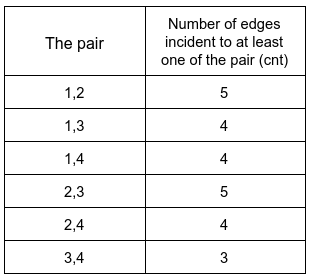Given a 0-indexed integer array nums of length n and an integer k, return the number of pairs(i, j)where0 <= i < j < n, such thatnums[i] == nums[j]and(i * j)is divisible byk.
Example 1:
Input: nums = [3,1,2,2,2,1,3], k = 2 Output: 4 Explanation: There are 4 pairs that meet all the requirements: - nums[0] == nums[6], and 0 * 6 == 0, which is divisible by 2. - nums[2] == nums[3], and 2 * 3 == 6, which is divisible by 2. - nums[2] == nums[4], and 2 * 4 == 8, which is divisible by 2. - nums[3] == nums[4], and 3 * 4 == 12, which is divisible by 2.
Example 2:
Input: nums = [1,2,3,4], k = 1 Output: 0 Explanation: Since no value in nums is repeated, there are no pairs (i,j) that meet all the requirements.
Constraints:
1 <= nums.length <= 1001 <= nums[i], k <= 100
Solution: Brute Force
Time complexity: O(n2)
Space complexity: O(1)
C++
|
1 2 3 4 5 6 7 8 9 10 11 12 |
// Author: Huahua class Solution { public: int countPairs(vector<int>& nums, int k) { const int n = nums.size(); int ans = 0; for (int i = 0; i < n; ++i) for (int j = i + 1; j < n; ++j) ans += (nums[i] == nums[j]) && (i * j % k == 0); return ans; } }; |


